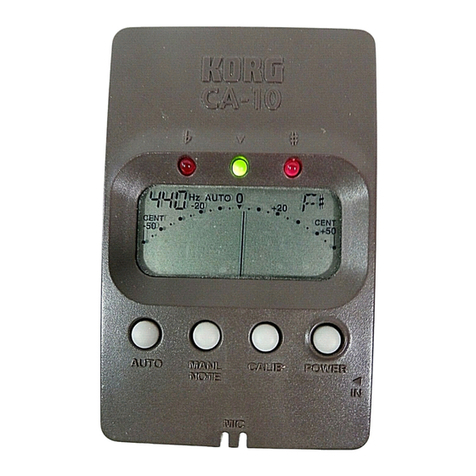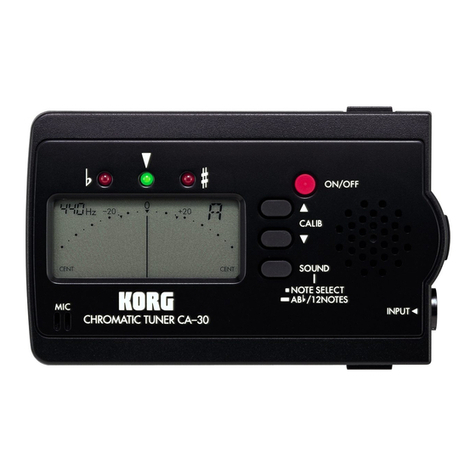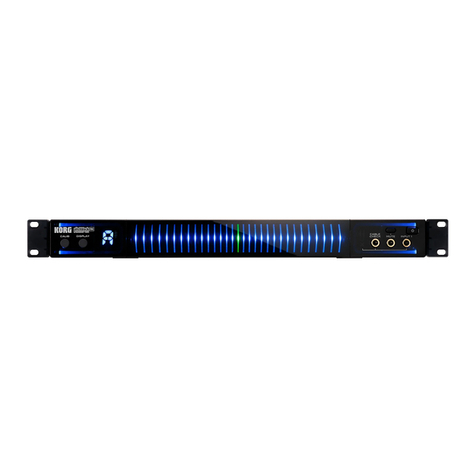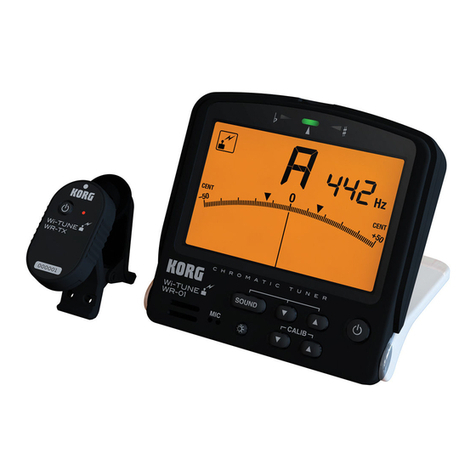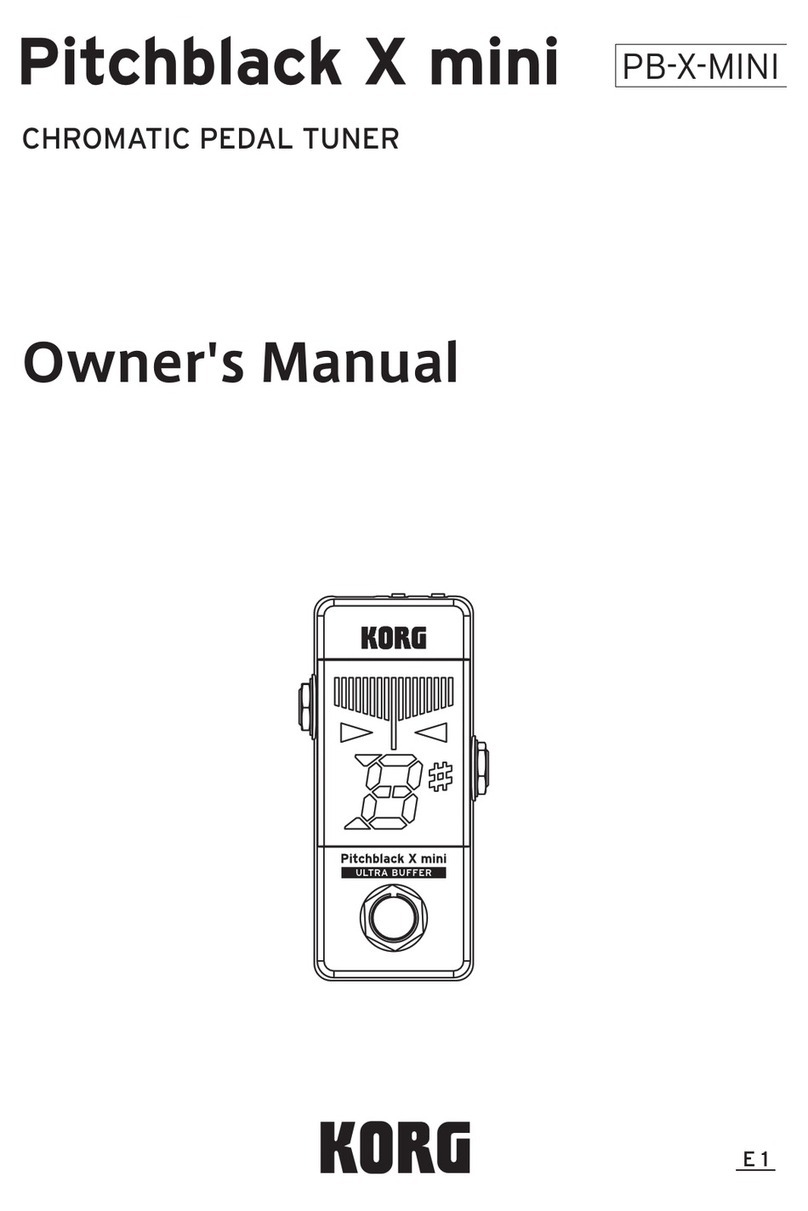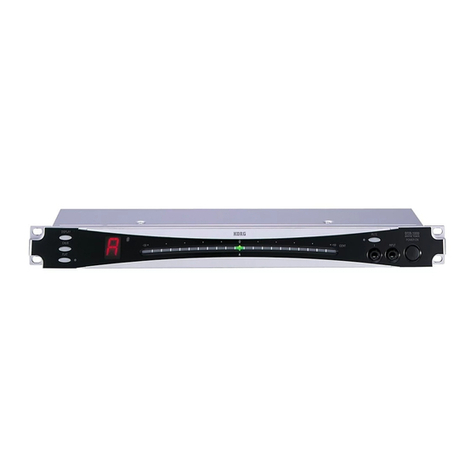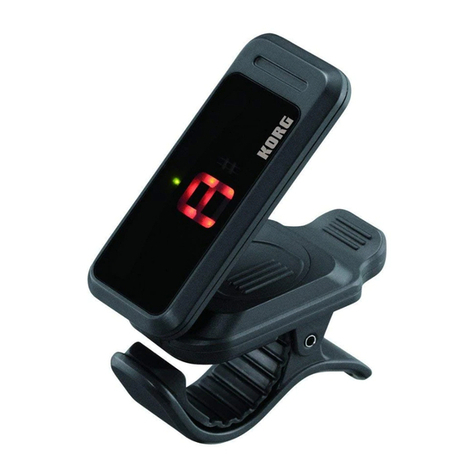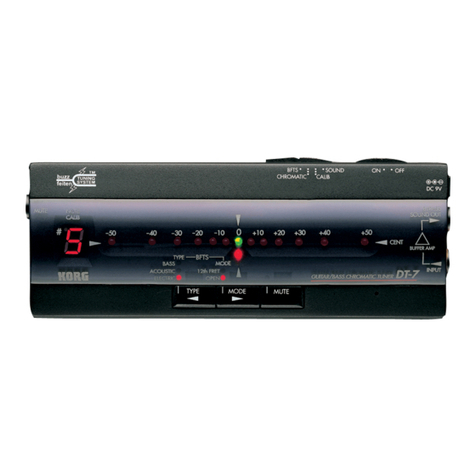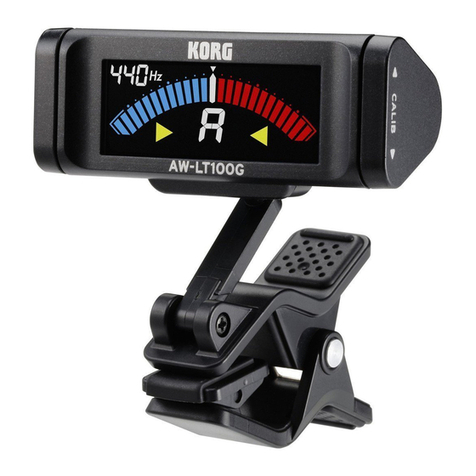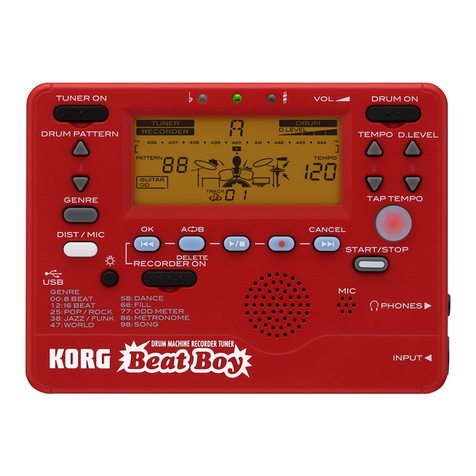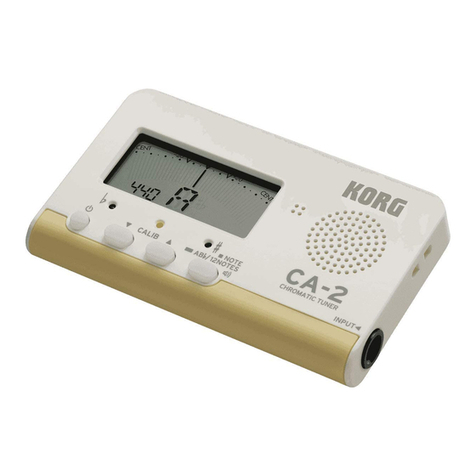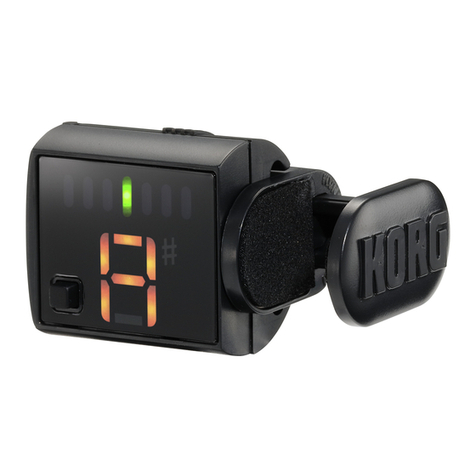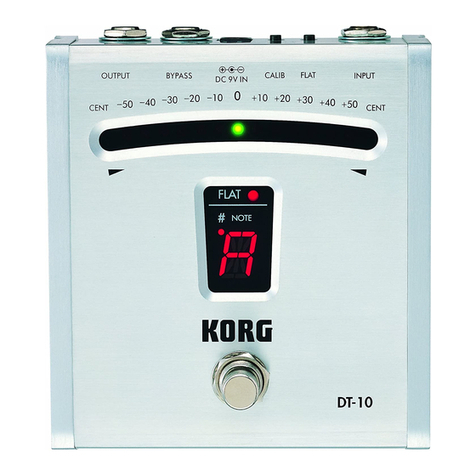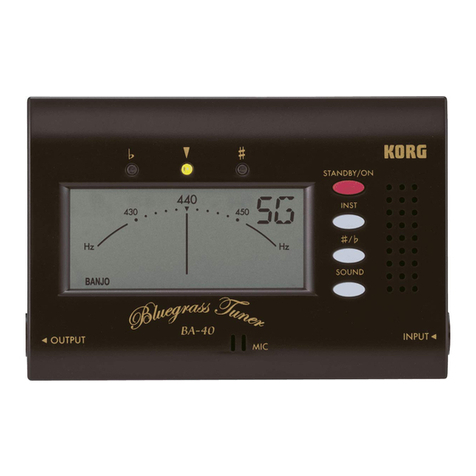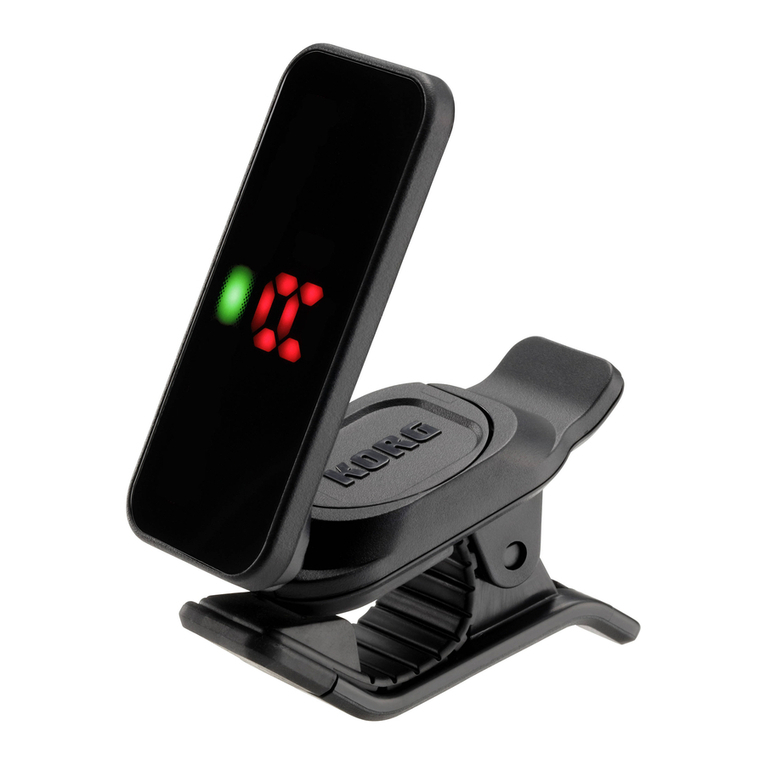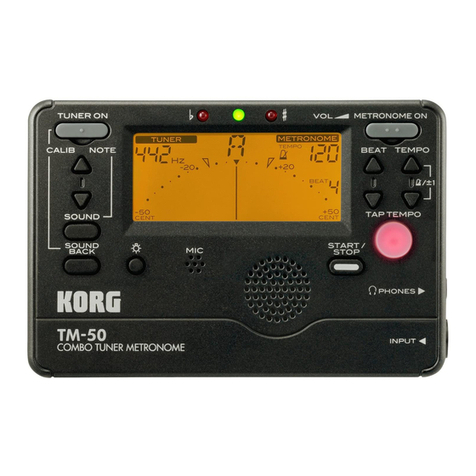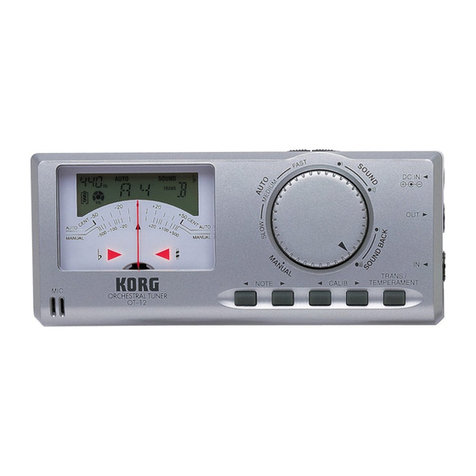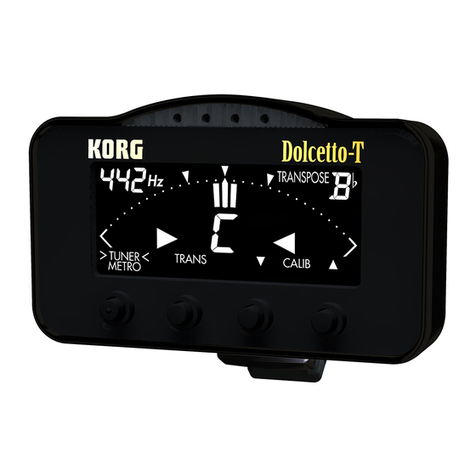
Precautions
Location
Using the unit in the following locations can result in a malfunction.
• In direct sunlight
• Locations of extreme temperature or humidity
• Excessively dusty or dirty locations
• Locations of excessive vibration
• Close to magnetic fields
Power supply
Be sure to turn the power switch to OFF when the unit is not in use. Remove the battery in order to
prevent it from leaking when the unit is not in use for extended periods.
Interference with other electrical devices
Radios and televisions placed nearby may experience reception interference. Operate this unit
at a suitable distance from radios and televisions.
Handling
To avoid breakage, do not apply excessive force to the switches or controls.
Care
If the exterior becomes dirty, wipe it with a clean, dry cloth. Do not use liquid cleaners such as
benzene or thinner, or cleaning compounds or flammable polishes.
Keep this manual
After reading this manual, please keep it for later reference.
Keeping foreign matter out of your equipment
Never set any container with liquid in it near this equipment. If liquid gets into the equipment, it
could cause a breakdown, fire, or electrical shock. Be careful not to let metal objects get into the
equipment.
Notice regarding disposal (EU only)
When this “crossed-out wheeled bin” symbol is displayed on the product, owner’s manual,
battery, or battery package, it signifies that when you wish to dispose of this product, manual,
package or battery you must do so in an approved manner. Do not discard this product,
manual, package or battery along with ordinary household waste. Disposing in the correct
manner will prevent harm to human health and potential damage to the environment. Since
the correct method of disposal will depend on the applicable laws and regulations in your
locality, please contact your local administrative body for details. If the battery contains
heavy metals in excess of the regulated amount, a chemical symbol is displayed below the
“crossed-out wheeled bin” symbol on the battery or battery package.
THE FCC REGULATION WARNING (for USA)
This equipment has been tested and found to comply with the limits for a Class B digital device, pursu-
ant to Part 15 of the FCC Rules. These limits are designed to provide reasonable protection against
harmful interference in a residential installation. This equipment generates, uses, and can radiate radio
frequency energy and, if not installed and used in accordance with the instructions, may cause harmful
interference to radio communications. However, there is no guarantee that interference will not occur in
a particular installation. If this equipment does cause harmful interference to radio or television recep-
tion, which can be determined by turning the equipment off and on, the user is encouraged to try to
correct the interference by one or more of the following measures:
•Reorient or relocate the receiving antenna.
•Increase the separation between the equipment and receiver.
•Connect the equipment into an outlet on a circuit different from that to which the receiver is con-
nected.
•Consult the dealer or an experienced radio/TV technician for help.
Unauthorized changes or modification to this system can void the user’s authority to operate this equip-
ment.
Parts of the AW-2+ and what they do
Internal mic
Note name indicator
Reference pitch indicator
High(+) indicator
Pure major third,
Pure minor third
Input indicator
Input select button
Clip attachment slot
Light button
Calib button
Power button Battery cover
Trans button
Transpose
indicator
Tuning procedure
1. Press the power button. The power will turn on/off when you press
this button.
If the power is left on for approximately 20 minutes without any sound
being input, it will turn off automatically.
2. If necessary, press the light button to set the backlight.(*M)
Each time you press the light button, the setting will cycle between
soft →auto →unlit →soft ...
Soft: To conserve battery life, the illumination will remain low.
Auto: The backlight will light up brightly when sound is input or
when a button is pressed. When there has been no input or
button use for approximately ten seconds, the backlight will
change to the "Soft" level of brightness.
Unlit: The backlight is off.
3. Use the input select button to choose the sound input source. (Please
refer to the "Recommended locations for attachment" section)
The setting will alternate between Mic and Piezo each time you press
the button.(*M)
4. If you want to change the standard pitch (calibration), press the
Calib button.
Each time you press the button, the setting will rise in 1 Hz incre-
ments. If you hold down the button, the setting will be reset to 440
Hz in approximately one second; if you continue holding down the
button, the setting will continue rising in 10 Hz increments (450 →
460 →470 →410 →420 →430 →440 →450 ...).(*M)
5. Play a single note on your instrument.
The display will show the name of the note that's closest to the pitch
detected. Tune your instrument to the correct pitch so that the de-
sired note name appears.
6. Once again play a single note on your instrument, and adjust the
tuning so that the center segment of the meter is lit up.
The right (+) indicator will light up if the pitch is too high, and the
left (-) indicator will light up if the pitch is too low.
You have the option of reversing the direction of the AW-2+'s meter be-
tween left and right, but in our explanation here we will assume that the
High (+) indicator is located on the right side.
If you want to tune to a pure major third (-13.7 cents) or pure minor
third (+15.6 cents) above a certain note, adjust the pitch to the pure
major or minor third marks in the meter.
For example if you want to tune to a pure major third (-13.7 cents) above
A (0 cents), make the note name indicator read C, and tune so that the
meter indicates the left [ ]. Alternatively, if you want to tune to a pure
minor third (+15.6 cents) above A (0 cents), make the note name indica-
tor read C, and tune so that the meter indicates the right [ ].
Avoid letting the mic pick up any extraneous sound while tuning.
Even if the pitch is within the range of detection, it may not be possible to
detect the pitch of an instrumental sound that contains large numbers of
overtones or that has a rapid decay (e.g., very low or very high notes on a
piano).
Transpose*M
You can use this function when tuning a transposing instrument. Each
time you press the Trans button, the setting will step through the choices
F →B→E→C (no transposition; the Transpose indicator will not ap-
pear). The display will show the Transpose indicator and the key that
you specified.
Reverse the meter display (Reverse function)*M
When turning the power on, hold down the power button for one sec-
ond or longer (the backlight will blink twice). Each time you repeat these
steps, the High (+) indication will be exchanged between left and right.
Select the position that feels most natural for the instrument where you've
attached the AW-2+.
Installing the battery
Turn the power switch off before you install or replace the battery. The bat-
tery that's included with the AW-2+ is for the purpose of verifying that the
unit functions correctly, and may not have a very long life.
When the battery begins to run low, the liquid crystal display (in particu-
lar the meter movement) will become lighter and the backlight will be-
come dimmer. The AW-2+ will continue to function for a while longer,
but tuning will become less accurate. Replace the battery as soon as pos-
sible.
1. With the ball of your thumb, lightly press the battery cover located
on the back of the AW-2+, turn it counter-clockwise, and remove it.
2. Replace the battery, being sure to observe the correct polarity so that
the "+" side of the battery is visible.
3. Turn the battery cover clockwise to reattach it.
Specifications
Scale: 12-note equal temperament
Range(sine wave): A0 (27.50 Hz)–C8 (4186 Hz)
Precision: +/-1 cent
Reference pitch: 410...480 Hz (1 Hz steps)
Transposition range: C, F, B, E
Dimensions: 58 mm (W) x 26 mm (D) x 12.6 mm (H)
2.28’’ (W) x 1.02’’ (D) x 0.50’’ (H) (unit only)
Weight: unit only 17.4 g/0.61 oz. (including battery)
Clip 17.7 g/0.62 oz. (large), 3.7 g/0.13 oz. (small)
Battery life: approximately 150/75/20 hours (backlight: unlit/
soft/auto, tuner continuously operating, A4 input)
Included items: CR2032 lithium battery (3V) for checking operation
Instrument clip
*MSettings are remembered even when the power is off. However, settings
will be initialized when you replace the battery (default: Calib=440 Hz,
No transposition (C), Piezo, right side High, backlight is unlit).
•Specifications and appearance are subject to change without notice for
improvement.
Attaching the included clip
Yes
No
Meter surface Attach
Remove
Large Clip
Small Clip
Joint
Firmly press the clip all the way into the attachment slot, making sure
that it's oriented correctly. To remove the clip, grasp the AW-2+, and re-
move the clip by pressing it at the location marked in the illustration.
Do not attempt to insert anything other than the included clip. Doing so may
damage the connector or other parts.
Do not attempt to remove the clip by pulling the jaws of the large clip. Doing
so may cause the joint to come apart, or may damage the clip.
IMPORTANT NOTICE TO CONSUMERS
This product has been manufactured according to strict specifications and voltage requirements that
are applicable in the country in which it is intended that this product should be used. If you have
purchased this product via the internet, through mail order, and/or via a telephone sale, you must verify
that this product is intended to be used in the country in which you reside.
WARNING: Use of this product in any country other than that for which it is intended could be danger-
ous and could invalidate the manufacturer's or distributor's warranty.
Please also retain your receipt as proof of purchase otherwise your product may be disqualified from
the manufacturer's or distributor's warranty.
This device complies with Part 15 of the FCC Rules.
Operation is subject to the following two conditions:
(1) This device may not cause harmful interference,
and (2) this device must accept any interference
received, including interference that may cause
undesired operation.
Complies with Canadian ICES-003 Class B.
Conforme au Reglement Canadian NMB-003 classe B.
CALIFORNIA USA ONLY
This Perchlorate warning applies only
to primary CR (Manganese Dioxide)
Lithium coin cells sold or distributed
ONLY in California USA.
“Perchlorate Material–special handling
may apply, See www.dtsc.ca.gov/
hazardouswaste/perchlorate.”
4015-2 Yanokuchi, Inagi-city, Tokyo 206-0812 Japan
C2012 KORG INC.
Thank you for purchasing the Korg AW-2+ Clip-on Orchestral Tuner.
Merci d’favoir choisi la Clip-on Orchestral Tuner AW-2+ de Korg.
Vielen Dank, dass Sie sich für einen AW-2+ Clip-on Orchestral Tuner
von Korg entschieden haben.
Gracias por comprar el afinador para enchufar AW-2+ Clip-on Orches-
tral Tuner de Korg.
Clip-on Orchestral Tuner
OWNER’S MANUAL
MANUEL D’UTILISATION
BEDIENUNGSANLEITUNG
MANUAL DE USUARIO
Note concernant les dispositions (Seulement EU)
Quand un symbole avec une poubelle barrée d’une croix apparait sur le produit, le mode d’em-
ploi, les piles ou le pack de piles, cela signifie que ce produit, manuel ou piles doit être déposé
chez un représentant compétent, et non pas dans une poubelle ou toute autre déchetterie
conventionnelle. Disposer de cette manière, de prévenir les dommages pour la santé humaine
et les dommages potentiels pour l'environnement. La bonne méthode d'élimination dépendra
des lois et règlements applicables dans votre localité, s’il vous plaît, contactez votre organisme
administratif pour plus de détails. Si la pile contient des métaux lourds au-delà du seuil régle-
menté, un symbole chimique est affiché en dessous du symbole de la poubelle barrée d’une
croix sur la pile ou le pack de piles.
REMARQUE IMPORTANTE POUR LES CLIENTS
Ce produit a été fabriqué suivant des spécifications sévères et des besoins en tension applicables dans le
pays où ce produit doit être utilisé. Si vous avez acheté ce produit via l’internet, par vente par correspon-
dance ou/et vente par téléphone, vous devez vérifier que ce produit est bien utilisable dans le pays où vous
résidez.
ATTENTION: L’utilisation de ce produit dans un pays autre que celui pour lequel il a été conçu peut être
dangereuse et annulera la garantie du fabricant ou du distributeur. Conservez bien votre récépissé qui est
la preuve de votre achat, faute de quoi votre produit ne risque de ne plus être couvert par la garantie du
fabricant ou du distributeur.
Précautions
Emplacement
L'utilisation de cet instrument dans les endroits suivants peut en entraîner le mauvais fonctionne-
ment.
• En plein soleil
• Endroits très chauds ou très humides
• Endroits sales ou fort poussiéreux
• Endroits soumis à de fortes vibrations
• A proximité de champs magnétiques
Alimentation
Lorsque vous n’utilisez pas l’appareil, n’oubliez pas de le mettre hors tension. Retirez les piles pour
éviter toute fuite lorsque l’appareil ne sera pas utilisé pendant de longues périodes de temps.
Interférences avec d'autres appareils électriques
Les postes de radio et de télévision situés à proximité peuvent par conséquent souffrir d'interféren-
ces à la réception. Veuillez dès lors faire fonctionner cet appareil à une distance raisonnable de
postes de radio et de télévision.
Maniement
Pour éviter de les endommager, manipulez les commandes et les boutons de cet instrument avec
soin.
Entretien
Lorsque l'instrument se salit, nettoyez-le avec un chiffon propre et sec. Ne vous servez pas d'agents
de nettoyage liquides tels que du benzène ou du diluant, voire des produits inflammables.
Conservez ce manuel
Après avoir lu ce manuel, veuillez le conserver soigneusement pour toute référence ultérieure.
Evitez toute intrusion d'objets ou de liquide
Ne placez jamais de récipient contenant du liquide près de l'instrument. Si le liquide se renverse ou
coule, il risque de provoquer des dommages, un court-circuit ou une électrocution.Veillez à ne pas
laisser tomber des objets métalliques dans le boîtier (trombones, par ex.).
Vorsichtsmaßnahmen
Aufstellungsort
Vermeiden Sie das Aufstellen des Geräts an Orten, an denen
• es direkter Sonneneinstrahlung ausgesetzt ist;
• hohe Feuchtigkeit oder Extremtemperaturen auftreten können;
• Staub oder Schmutz in großen Mengen vorhanden sind;
• das Gerät Erschütterungen ausgesetzt sein kann.
• in der Nähe eines Magnetfeldes.
Stromversorgung
Stellen Sie den Netzschalter auf OFF, wenn das Gerät nicht benutzt wird. Wenn Sie das Gerät über einen
längeren Zeitraum nicht benutzen, nehmen Sie die Batterien heraus, damit sie nicht auslaufen.
Störeinflüsse auf andere Elektrogeräte
Dieser kann bei in der Nähe aufgestellten Rund-funkempfängern oder Fernsehgeräten Empfangsstörungen
hervorrufen. Betreiben Sie solche Geräte nur in einem geeigneten Abstand von diesem Erzeugnis.
Bedienung
Vermeiden Sie bei der Bedienung von Schaltern und Reglern unangemessenen Kraftaufwand.
Reinigung
Bei auftretender Verschmutzung können Sie das Gehäuse mit einem trockenen, sauberen Tuch abwischen.
Verwenden Sie keinerlei Flüssigreiniger wie beispielsweise Reinigungsbenzin, Verdünnungs- oder Spülmittel.
Verwenden Sie niemals brennbare Reiniger.
Bedienungsanleitung
Bewahren Sie diese Bedienungsanleitung gut auf, falls Sie sie später noch einmal benötigen.
Flüssigkeiten und Fremdkörper
Stellen Sie niemals Behältnisse mit Flüssigkeiten in der Nähe des Geräts auf. Wenn Flüssigkeit in das Gerät
gelangt, können Beschädigung des Geräts, Feuer oder ein elek-trischer Schlag die Folge sein. Beachten Sie,
daß keinerlei Fremdkörper in das Gerät gelangen.
Hinweis zur Entsorgung (Nur EU)
Wenn Sie das Symbol mit der „durchgekreuzten Mülltonne“ auf Ihrem Produkt, der dazugehö-
rigen Bedienungsanleitung, der Batterie oder dem Batteriefach sehen, müssen Sie das Pro-
dukt in der vorgeschriebenen Art und Weise entsorgen. Dies bedeutet, dass dieses Produkt mit
elektrischen und elektronischen Komponenten nicht mit dem normalen Hausmüll entsorgt wer-
den darf. Für Produkte dieser Art existiert ein separates, gesetzlich festgelegtes Entsorgungs-
system. Gebrauchte elektrische und elektronische Geräte müssen separat entsorgt werden,
um ein umweltgerechtes Recycling sicherzustellen. Diese Produkte müssen bei benannten
Sammelstellen abgegeben werden. Die Entsorgung ist für den Endverbraucher kostenfrei! Bit-
te erkundigen sie sich bei ihrer zuständigen Behörde, wo sie diese Produkte zur fachgerechten
Entsorgung abgeben können. Falls ihr Produkt mit Batterien oder Akkumulatoren ausgerüstet
ist, müssen sie diese vor Abgabe des Produktes entfernen und separat entsorgen (siehe oben). Die Abga-
be dieses Produktes bei einer zuständigen Stelle hilft ihnen, dass das Produkt umweltgerecht entsorgt
wird. Damit leisten sie persönlich einen nicht unerheblichen Beitrag zum Schutz der Umwelt und der mensch-
lichen Gesundheit vor möglichen negativen Effekten durch unsachgemäße Entsorgung von Müll. Batterien
oder Akkus, die Schadstoffe enthalten, sind auch mit dem Symbol einer durchgekreuzten Mülltonne ge-
kennzeichnet. In der Nähe zum Mülltonnensymbol befindet sich die chemische Bezeichnung des Schad-
stoffes.
Cd oder NiCd steht für Cadmium, Pb für Blei und Hg für Quecksilber.
WICHTIGER HINWEIS FÜR KUNDEN
Dieses Produkt wurde unter strenger Beachtung von Spezifikationen und Spannungsanforderungen her-
gestellt, die im Bestimmungsland gelten. Wenn Sie dieses Produkt über das Internet, per Postversand und/
oder mit telefonischer Bestellung gekauft haben, müssen Sie bestätigen, dass dieses Produkt für Ihr Wohn-
gebiet ausgelegt ist.
WARNUNG: Verwendung dieses Produkts in einem anderen Land als dem, für das es bestimmt ist, ver-
wendet wird, kann gefährlich sein und die Garantie des Herstellers oder Importeurs hinfällig lassen wer-
den. Bitte bewahren Sie diese Quittung als Kaufbeleg auf, da andernfalls das Produkt von der Garantie des
Herstellers oder Importeurs ausgeschlossen werden kann.

